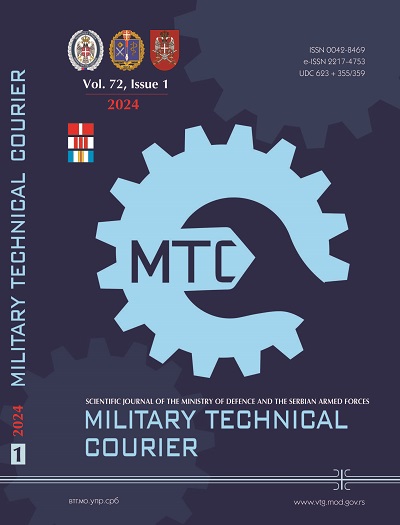Mathematical modeling and simulation of a half-vehicle suspension system in the roll plane
Abstract
Introduction/purpose: The study of vehicle suspension is a challenge for researchers in the field of vehicles regarding the impact of the suspension system on vehicle performances such as ride comfort, road holding, and working space. This paper presents the simulation of the Land Rover Defender 110 vehicle in the roll plane (half vehicle) in Simulink/MATLAB. The obtained results were compared with the results obtained in the ADAMS/CAR software package of the Land Rover Defender 110 simulation model previously experimentally validated. The Defender 110 vehicle has a dependent suspension system in both axles and a passive suspension type with four degrees of freedom (4 DOF).
Methods: The equations of the system can be solved mathematically with a scheme in Simulink/MATLAB while half-vehicle modeling has been done in ADAMS/CAR.
Results: The comparison of the vehicle characteristics obtained by the two simulation methods was done for three different scenarios, and it was noticed that there is a good correlation between them.
Conclusion: It was concluded that the Defender 110 vehicle simulation model in Simulink/MATLAB is validated. The validated model can be used to perform suspension system optimization in future work.
References
Baumal, A., McPhee, J. & Calamai, P. 1998. Application of genitic algorithms to the design optimization of an active vehicle suspension system. Computer Methods in Applied Mechanics and Engineering, pp.87-94. Available at:https://doi.org/10.1016/S0045-7825(98)00004-8
Khettou, N., Trifkovic, D. & Muzdeka, S. 2016. Using Modelling and Simulation to Predict dynamics of converted Ground Vehicle. Defence Science Journal, 66(5), pp.509-516 [online]. Available at: https://pdfs.semanticscholar.org/f966/41f034630dbe59ba6fb052b69a0ef8c2d345.pdf [Accessed: 5 November 2023].
Mitra, A., Benerjee, N., Khalane, H., Sonawane, M., Joshi, D. & Bagul, G. 2013. Simulation and Analysis of Full Car Model for various Road profile on a analytically validated MATLAB/SIMULINK model. Journal of Mechanical and Civil Engineering, pp.22-33 [online]. Available at: http://iosrjournals.org/iosr-jmce/papers/RDME-Volume1/RDME-4.pdf [Accessed: 5 November 2023].
Mitra, A.C., Fernandez, E., Nawpute, K., Sheth, S., Kadam, V. & Chikhale, S.J. 2018. Development and Validation of a Simulation Model of Automotive Suspension System using MSC-ADAMS. Materials Today: Proceedings, 5(2), pp.4327-4334. Available at: https://doi.org/10.1016/j.matpr.2017.11.698.
Turakhia, T. & Modi, M. 2016. Mathematical Modeling and Simulation of a Simple Quarter Car Vibration Model. International Journal for Scientific Research & Development, 3(11), pp.448-450 [online]. Available at: https://ijsrd.com/Article.php?manuscript=IJSRDV3I110139 [Accessed: 5 November 2023].
Žuraulis, V., Levulytė, L. & Sokolovskij, E. 2014. The impact of road roughness on the duration of contact between a vehicle wheel and road surface. Transport, 29(4), pp.431-439. Available at: https://doi.org/10.3846/16484142.2014.984330.
Copyright (c) 2024 Abdeselem Benmeddah, Momir M. Drakulić, Aleksandar S. Đurić, Sreten R. Perić, Aleksandar G. Bukvić, Abdellah B. Ferfouri

This work is licensed under a Creative Commons Attribution 4.0 International License.
Proposed Creative Commons Copyright Notices
Proposed Policy for Military Technical Courier (Journals That Offer Open Access)
Authors who publish with this journal agree to the following terms:
Authors retain copyright and grant the journal right of first publication with the work simultaneously licensed under a Creative Commons Attribution License that allows others to share the work with an acknowledgement of the work's authorship and initial publication in this journal.
- Authors are able to enter into separate, additional contractual arrangements for the non-exclusive distribution of the journal's published version of the work (e.g., post it to an institutional repository or publish it in a book), with an acknowledgement of its initial publication in this journal.
- Authors are permitted and encouraged to post their work online (e.g., in institutional repositories or on their website) prior to and during the submission process, as it can lead to productive exchanges, as well as earlier and greater citation of published work (See The Effect of Open Access).

